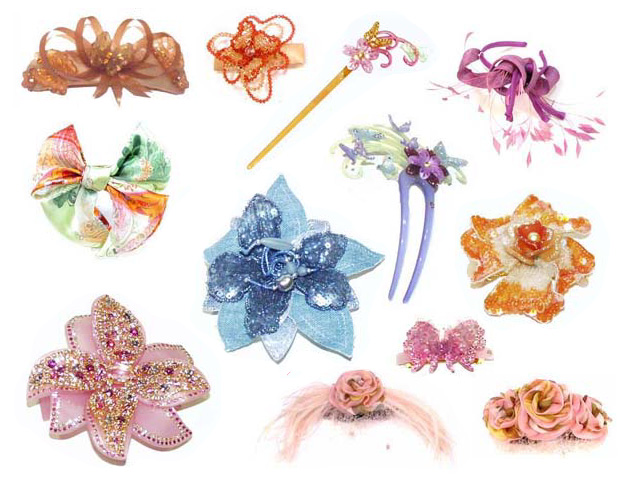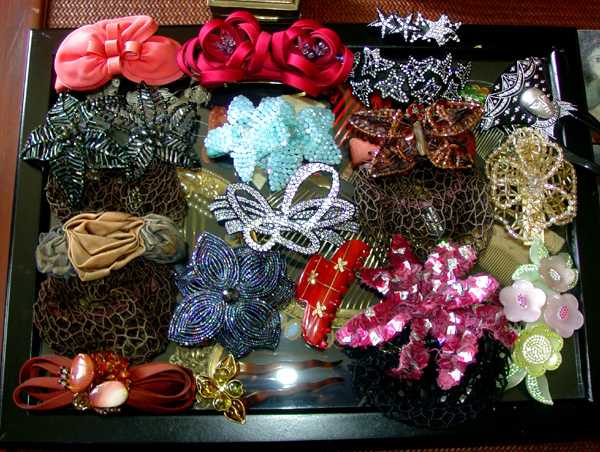Well, it’s haute couture show season in Paris — I’m sure we are all booking our hotel rooms at the Ritz and getting our invitations in order — after we clean our cats’ litter boxes and make sure our rose leaves are chemically protected from blackspot during their sleeping period in February, so when they bloom in March they will be beautiful, ;-P, but…
Fortunately we can see the mind-blowing ideas from the greatest artists in the world, which are gracing the Paris runways through the miracle of the Internet.
This year, Lacroix did head pieces that made me faint. Unique crystal beaded creations sewn into mesh head bands that were worn on the side of the head, combined with huge fabric flowers, sometimes ornamented with butterflies, and a huge black satin bow in the back. The beading work by the attelier who created these necklaces is at a masterwork level from another century. Lacroix called his collection “An Angel Passing By.” My world has changed.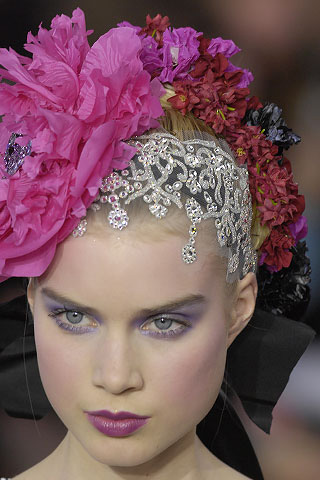
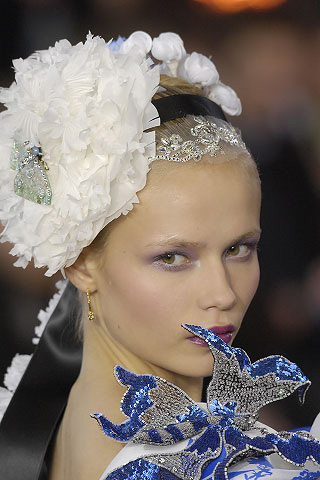
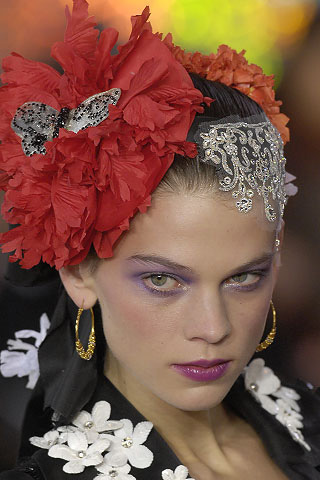
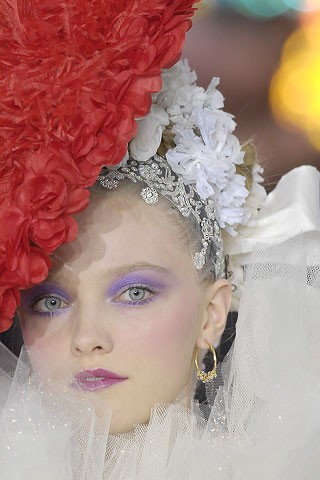
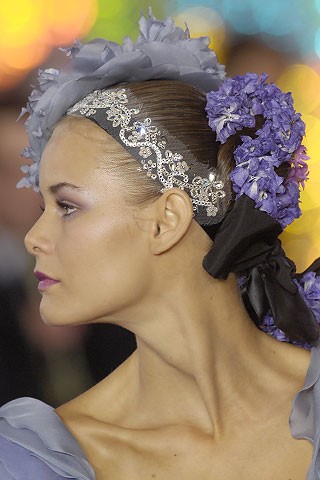
And I couldn’t resist showing 4 dresses from his Spring 2008 haute couture collction that made me die.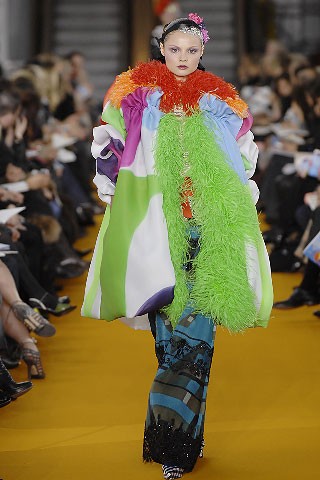
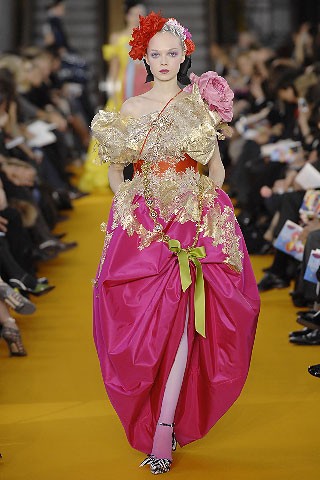
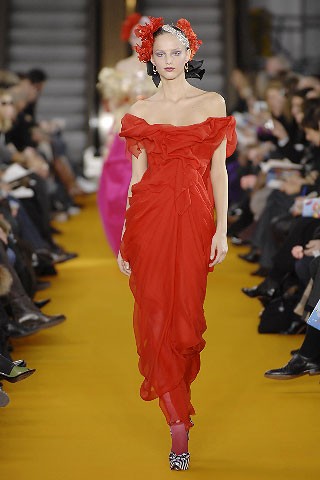
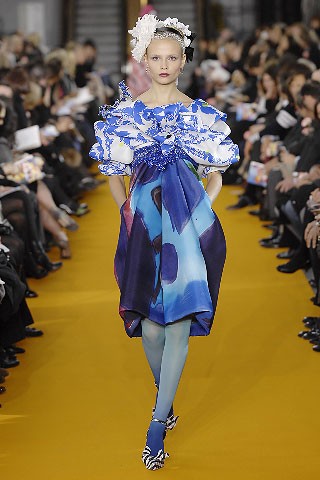
I was so inpsired by these ideas of how to ornament your hair, that I actually tried it at home! I guess this next picture goes with the “don’t try this at home, PLEASE.” ha! But I used my grandmother’s costume jewelry with this Hawaiian flower thing I bought on ebay for $15 about a year ago. I think when I go to Wal-Mart in South Georgia to get groceries, this would be the perfect outfit to wear! LMAO!!!!!!!!!!!
Maybe I should get a stylist. ha ha ha, lmao. I’m sure his services will be of great use when I’m painting my picket fence blue and the larger fence wall aqua green this summer. :-)
Oh Gracious Lord
The dealer advertises this to be a French sterling vermeil church crown to be used in the service at the altar. c. 1860-1880. It has hallmarks of Minerva and a Rooster. The crown is set with real diamonds, pearls, amethysts, and rubies. The amethysts are carved into bees and set with pave diamonds.
It was purchased in Paris from a dealer of religious artifacts, and is in perfect condition. All the stones are original. The crown measures 7 1/2 inches (tall) by 6 1/4 inches (at widest point) by 4 1/2 inches (across headband). The seller has not been able to determine who made it.
AND it’s on sale on ebay for the Sotheby’s-level price of $12,499. ;-) When you find something like this, it doesn’t really matter what the price is though. If you can get your hands on it, grab it. Unfortunately, most of us must worship from afar. I did some research on the internet, and this may be Belgian silver of the Empire period, with the rooster and Minerva markings, which would date it from 1831-1868. I don’t know. Comments welcome.
Of course the famous phrase comes to mind, “Great responsibility comes to those who wear the crown.” How can you not wonder who wore this?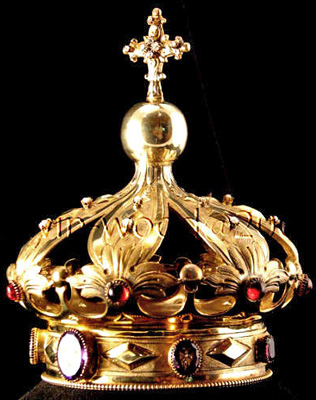
Parure Hair Ornaments
A full parure includes the matching necklace, 2 bracelets, brooch, ring, earrings, and a hair ornament or tiara. Today I have chosen 5 hair ornaments that are part of demi parures, which were worn in the Victorian period.
This coral hair ornament is on a black silk strap, highlighted by a principal carved coral flower framed by two smaller flowers and an assortment of buds and leaves. It was owned by Countess Rosamund Courten and dates c. 1850.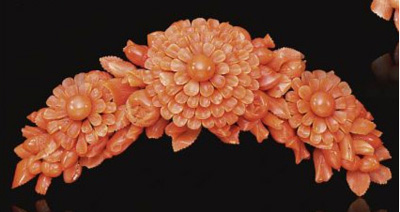
This gold, enamel, seed pearl, and lapis lazuli brooch attaches to a tortoiseshell comb. The lapis lazuli cabochons are embellished with a cannetille decoration. (Cannetille is a wirework decoration which uses coiled and twisted gold wire to achieve a delicate scrolling effect.) c. 1810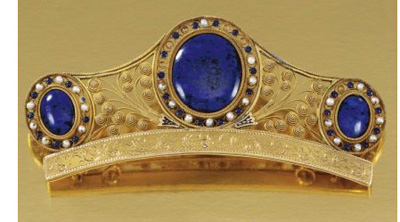
This gold hair ornament c. 1830 has a flowerspray design, set throughout with variously cut rock crystals in blue foiled settings. It also attaches to a tortoiseshell comb.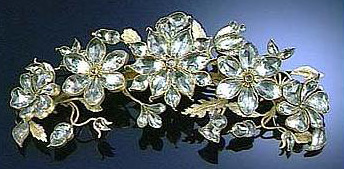
And finally, these two stunning pieces by Carlo Guiliano, a leader of the Revivalist Movement in mid-19th Century jewelry making. Each hair ornament is part of a different parure. c. 1850.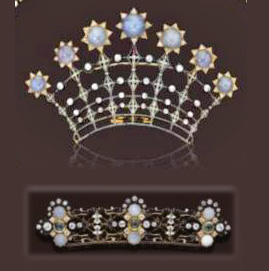
Some Lovely Things on Ebay
This 18K gold hair comb with a bamboo frame sold Jan 7 on ebay for $1102.77. It was made by Madison Ave. jewelry designer David Webb, who gave the traditional Japanese kushi shape his own unique, original interpretation.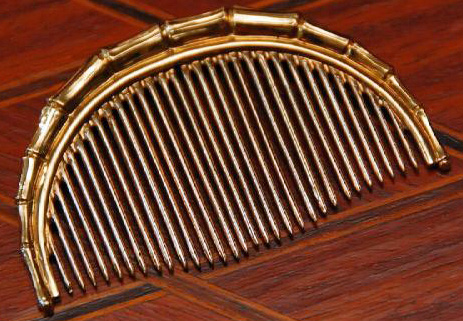

There was also an auction of Japanese combs, some pieces of which had great artistry. Of course, the combs were expensive because it costs a lot to get them, and many didn’t sell. I made a deal with the seller to buy this ivory kanzashi for $500 in installment payments because when I saw it, I freaked.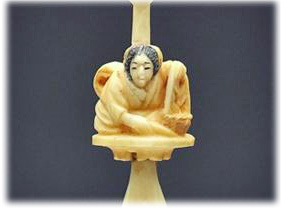
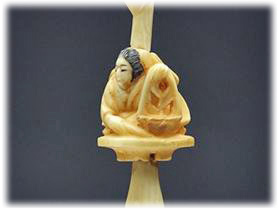
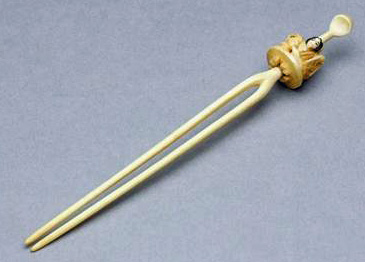
This beautiful Taisho kushi did not sell for a starting price of $480. It is tortoiseshell, painted with a greyish-black lacquer, and it has a toy theme. I think the colors and bold design are magnificent on this piece. The artist GYOKUSEI signed his work. Maybe if the kushi were in mint condition, it would have sold. You can never tell, but I remember a similar piece on Trocadero of a Noh mask selling for $1295. It took a year to sell that piece, but maybe it was by the same artist.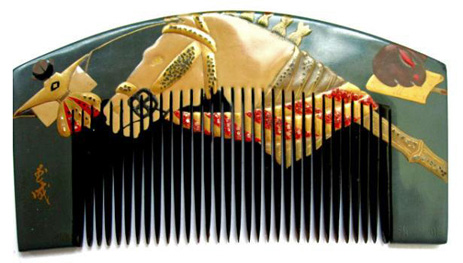
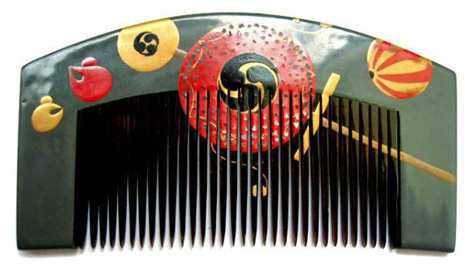
This Meiji blonde tortoiseshell kushi has a superb three-diminsional carving of an old traveler saying goodbye to birds dressed in kimonos, as he goes down the road into the mountains. The artist carved his painting on the front and back to give perspective. Again, the condition is not perfect, but the artistry is fabulous. What a unique theme, how elaborately it was expressed. I loved it, but it also did not sell for a starting price of $480.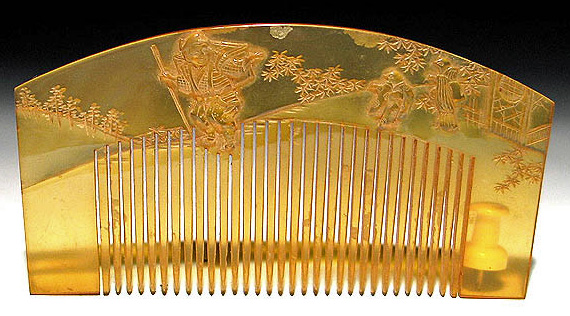
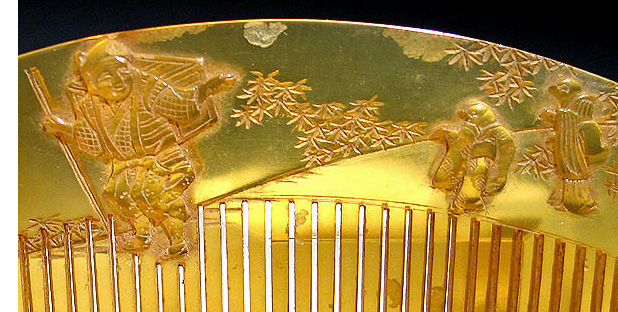
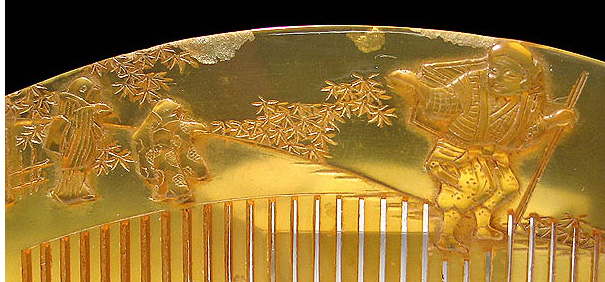
A seller wanted $5500 for this Russian Imperial tiara brooch/barrette that was advertised as being from Faberge and made for the Czar’s mistress, a Russian prima ballerina, but no one bought it. You may refer to Auction #250200100650.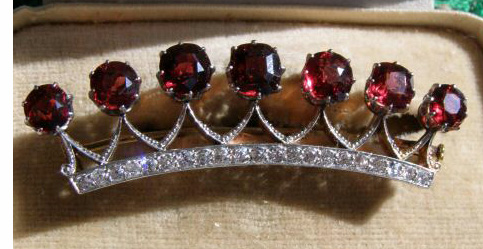
Finally, this lovely silver comb from the state of Rajasthan in North India, whose top is a receptacle to hold perfumed oil, sold for $152.50 on Dec 30. The cap is graced by two peacocks, who are the Hindu symbol for immortality. You may refer to Auction #290192625758. There is a dealer on Trocadero who is trying to sell a similar piece for $600, so this was a good buy. :-)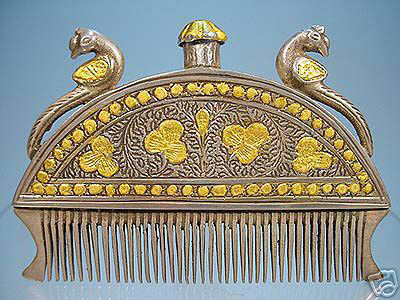
Some Lovely Things on Ebay and Beyond
There have been some lovely things listed recently on Ebay, and one I missed on Ruby Lane (dash!), that I’d like to share this beautiful Christmas Eve. I hope everyone is having a wonderful holiday.
These pink coral cabachons set in silver, marked 800, are highlighted with tiny seed pearls set in the leaves, and hinged onto a horn comb, c. 1880. I love it. It sold to myrnatoo, my nemesis and supposed best friend ;-P, for $245 on Ruby Lane.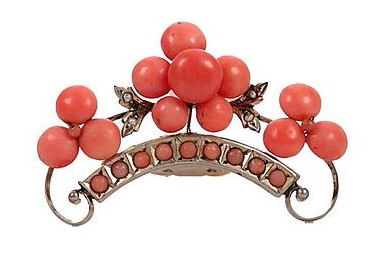
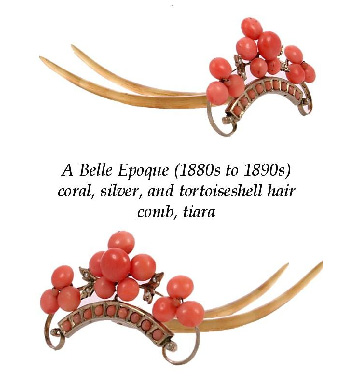
This beautifully designed Sterling silver comb featuring a makers mark: Hermann Duhme of Cincinnati, c. 1860, did not sell for an asking price of $399. I couldn’t afford it, but I thought it was lovely. Maybe overpriced, but the dealer might get her wish at another time, or lower the price $100. You may refer to Auction #110206067490.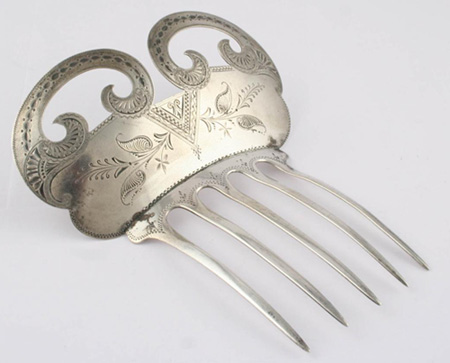
This silver-plated brass Japanese kanzashi in the form of a bird cage sold for $470.25. It is Meiji, and even has the small bird in the cage. Marvelous detail. You may refer to Auction #140186354336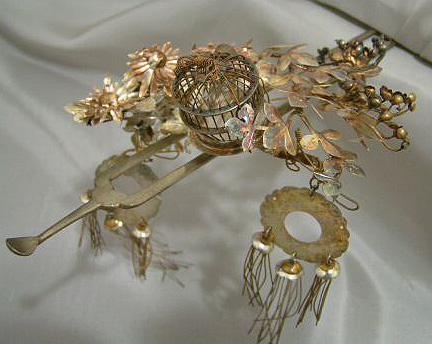
I am not sure how much this bird gold and silver kanzashi sold for. The seller was kofudo_jp. I didn’t save the auction, bleh, but I loved the very dramatic birdie.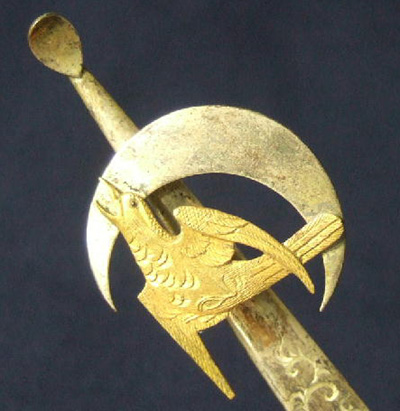
Finally, although I usually do not do celluloid combs, unless they are Bonaz, I liked this one anyway. The shape is very unusual and striking. This celluloid comb made to look like tortoiseshell sold for $102.50 on Nov 26. You may refer to Auction #250189964524.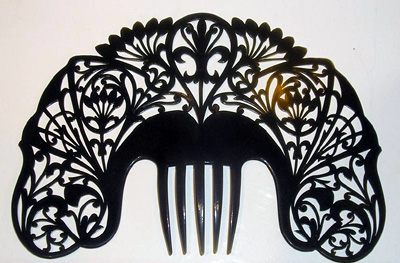
Necklace and Hair Comb
This Art Nouveau plique-á-jour enamel turquoise and diamond necklace and hair comb sold at Sothebys for $29,875 on Dec 10, 2002. The comb is a triangular cluster set with oval-shaped turquoise cabochons. These are the flowers coming out of translucent yellow-orange enamel buds, which are then surrounded by green plique-á-jour enamel leaves. The matching necklace also features old-mine and rose-cut diamonds.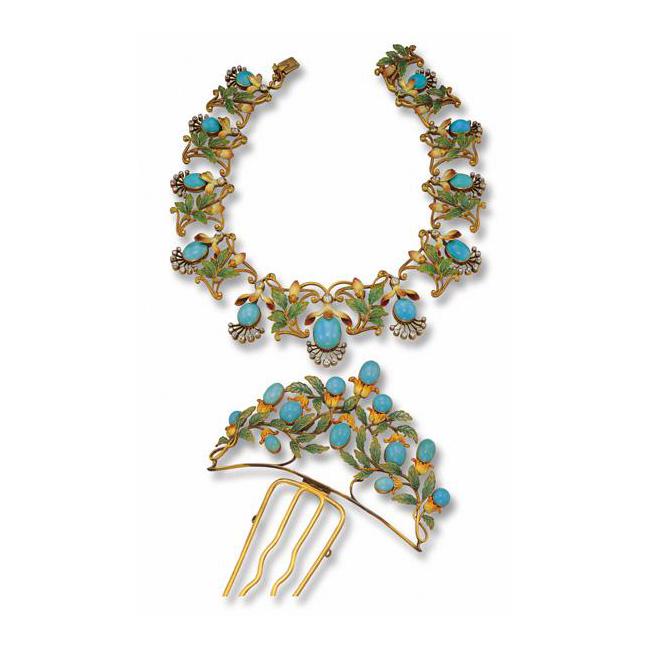
Opera Combs, Genius, and Schizophrenia
This is something I wrote for a health community I worked for. As I moderated the mental health communities there, I did an essay on Nijinsky, Le Sacre du Printemps, genius, madness, ballet, and the women in Paris in their beautiful opera combs who rioted on that famous night.
The Joffrey Ballet recreated Nijinsky’s original choreography to Sacre in 1987, and they put it on YouTube this year. Here are the links to the entire performance.
http://www.youtube.com/watch?v=bjX3oAwv_Fs
http://www.youtube.com/watch?v=vb8njeKBfqw
http://www.youtube.com/watch?v=mK64sTi4mKc
…
The 20th Century began a revolutionary change in the intellectual, decorative, and performance arts, as well as fashion, literature, and painting. The conformity and elegance of the Victorian period was giving way to movements such as Art Nouveau, where natural forms were being reworked and transformed into exquisite pieces of jewelry using new materials.
LC Tiffany was making leaded glass lamps into paintings of the natural world. Influenced by Japanese art and Symbolism, Lalique was elongating bird wings on hair combs to reinterpret how we understood ourselves. In each field, there were leaders, geniuses who saw the world as it was and imagined something radically different.
In ballet, there was Nijinsky. Lover to Diaghilev, who founded the ground-breaking Ballet Russes, Vaslav Nijinsky choreographed The Rite of Spring, Le Sacre du Printemps, Stravinsky’s visionary score about a pagan sacrifice in prehistoric Russia. It premiered May 29, 1913 in Paris.
In the Paris of 1913, ballerinas wore exquisite white costumes, danced in pink slippers with arched toes in perfect form to story plots, which always paid homage to princes and kings. Male partners lifted ballerinas to make them look as if they were floating on air, as one leg brushed the floor so softly as to make the audience gasp. Women were swans, fairies, maidens, sylphs, and princesses, who sacrificed their lives to forgive men’s amoral decisions (Giselle) or stupidity (Swan Lake). European culture was celebrated as having exquisite taste and gracefulness in its ultimate superiority.
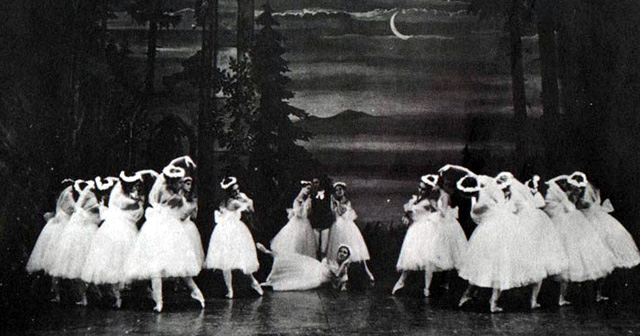
Les Sylphides as Nijinsky danced it in 1909
Into this world came Nijinsky and Sacre.
The dancer’s costumes were loose, unsophisticated, and unbecoming. Their toes were pointed in. Maidens had white makeup all over their faces, and men did stomping dances. The movements were spastic, clumsy, off-center, pack-like and raw. The society portrayed was pagan, with an old sage who signals it’s time to make a sacrifice. But there was no king, no Christian God, no church, no army, no awareness that people had to pay homage to anything but their adoration of the Earth.
In perhaps the most complex score ever to be written for ballet, Nijinsky chose simple, unsophisticated but brilliant movements, one to every beat, 2 beats, or 4 beats, making sure that dancers only expressed melody. He let Stravinsky’s radical ideas, dual tonality and dual rhythms, live by themselves. He also made his dancers go into the floor, a controversial innovation that Martha Graham also championed when she came on the scene in 1926.
At the end of Nijinsky’s Sacre, the girl being sacrificed dances with the spastic, shivering fear of a caged animal who knows she’s going to be killed but cannot escape. She is surrounded by pagans wearing bear skins, complete with the head, and making the movements of horses. At the last trill, she’s ready. She lays down, and offers her body. Eight men pick her up, hold her on top of their hands, and she’s dead.
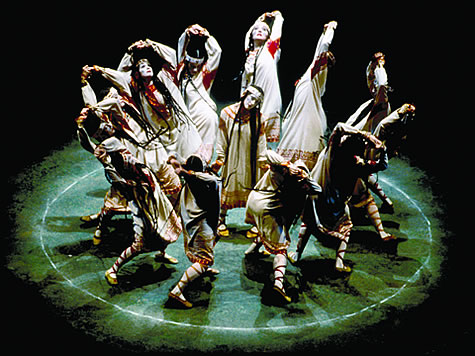
The Joffrey Ballet’s 1987 recreation of Nijinsky’s original 1913 Sacre
A sophisticated, beautifully dressed Parisian audience at the Théâtre de Champs-Elysées, with women who wore winged diamond tiaras, diamond opera combs, and chiffon gowns, had to see this savage portrayal done on white dancers. The audience had to contemplate that once European culture was primitive, that their sense of heirarchy, cultural superiority, and self-worship was irrelevant, at a Ballet Russes performance, at a time when Faberge was still making Easter Eggs for Czar Nicholas II.
A riot ensued.
Nijinsky was defended by Rodin, Odilon Redon, and Proust, but it was not enough. He was vilified. His heart could not bear the world’s scorn. He had a nervous breakdown in 1919, was diagnosed with schizophrenia, and lived in and out of hospitals and asylums for the rest of his life. A countess he married, and of whom Diaghilev was extremely jealous, devoted her life completely to his care, and Nijinsky died in a London clinic in 1950.
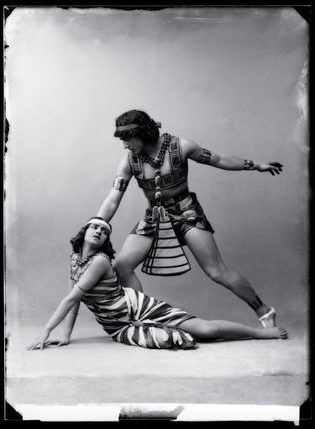
Nijinsky in Sacre, 1910
Opinions vary as to whether his wife’s plebian nature or the world’s rejection of his vision triggered Nijinsky’s schizophrenia, but to me it doesn’t matter.
An artist takes the world with him. LC Tiffany saw a Victorian oil lamp and invented favrile glass. He saw his father’s diamond opera combs and envisioned two dragonflies pollenating a dandelion. The world followed Tiffany.
Nijinsky danced in Mikhail Fokine’s Les Sylphides, which was premiered by his lover Diaghilev for the Ballet Russes on June 2, 1909. Four years later, he choreographed Sacre, and the world did not follow him. Nijinsky was 50 years ahead of his time.
What is schizophrenia? You hear voices. You see things that are bizarre to the world. Paranoid fantasies. Somatic delusions. Obscure and confused expressions. But in rare cases, may I be bold enough to suggest that the worst mental illness known to man can be triggered by a closed-minded world who breaks the heart of a genius?
Garnet Tiara
This beautiful deep-red garnet tiara, c.1880, set in a leaf design to a handmade gilded silver frame sold for 895 GPB today at Rowan and Rowan. Lovely.

Some Lovely Things on Ebay
There have been some beautiful things sold on ebay recently.
A beautiful tortoiseshell, gold makie, and coral kogai stick from the Edo period sold for $490 on Nov. 28. You may refer to Auction #300174753664.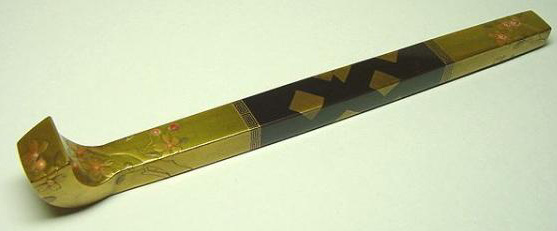
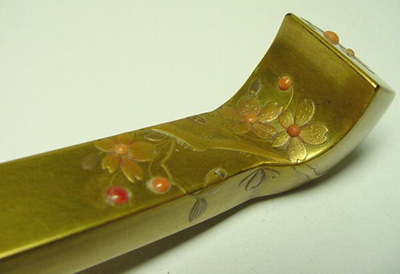
A Showa tortoiseshell kushi with two layers of leaves flowing in the wind sold for $257.82 on Nov. 25. You may refer to Auction #330189054886.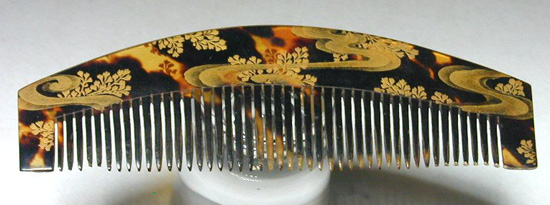
A gorgeously carved Victorian ivory comb went for the stunningly low price of $86 because two pieces of it were missing. When such a beauty, with no discoloration, has damage, I hold my head in my hands. Anyway, it was a great bargain, and a beautiful comb. You may refer to Auction #230197013812.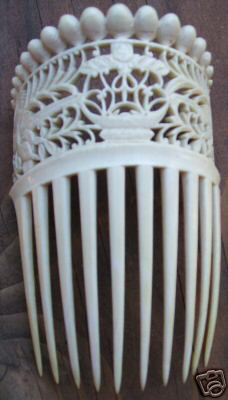
A beautiful 14K rose gold hair pin sold for $383 on Dec 6. You may refer to Auction #250193680625.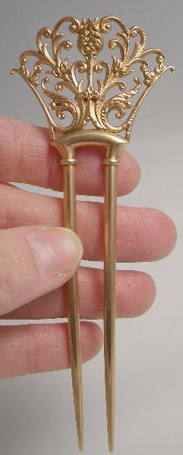
On Dec 10, this matching set of beautiful garnet butterfly hairpins went for $760. You may refer to Auction #170174938274.

This beautiful late Edo tortoiseshell kanzashi, c. 1850, sold for an excellent price of $152.53 on Dec 9. The pins are smaller because it was made to be worn at the front of the geisha’s wig. The quality of the shell is translucent blonde and extraordinary. You may refer to Auction #110201844429.
And finally, I bought this butterfly ivory comb on Ruby Lane recently for $245. It looks pretty discolored, but no pieces are missing, and I loved it, so c’est la. Update: I received it. It’s not discolored at all, and it’s huge. I’m thrilled with it.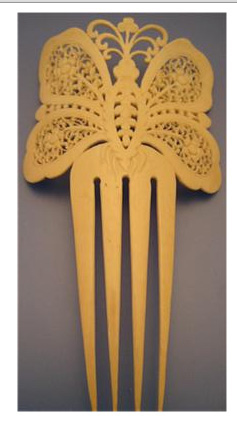
Alexandre de Paris
Very rarely will you see an ebay post for a modern hair ornament of this brand. When it does come up, they try to mimic the retail price, which no one will pay on ebay because no one really knows or has any emotional attachment to this brand.
Why? The only place you can buy these ornaments are in Paris, New York, Tokyo — in store. The company has no online presence whatsoever. No layaway, no mailing list, no messageboards, no notificiations of new items, no website, NOTHING!
I’ve been yelling at Jovy (the New York store manager) for years about this. She had a website up briefly, but then it came down. I can’t even get a picture of one of the couture ornaments I die for mailed to me, so I haven’t bought anything in years. However, when a site was briefly up, I did collect some pictures and put together a collage so you can see the handmade beading, fabric art and design that goes into these pieces. They are hand made by atteliers in Paris, so they qualify as haute couture hair pieces.
The real Alexandre de Paris was a hairdresser to the stars. Among others, he did Elizabeth Taylor’s hair when she filmed Cleopatra, and I really think this company’s designs are the heir to Auguste Bonaz’s great art deco combs. So picture 1 is my collage from a catalog long ago, where nothing pictured is remotely available. Picture 2 is my personal collection, which hasn’t been added to in years, but which of course looks like a total mess laid out on my glass vitrine ;-). They are kept in a vanity drawer.